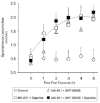The Behavioral and Pharmacological Actions of NMDA Receptor Antagonism are Conserved in Zebrafish Larvae
- PMID: 21278812
- PMCID: PMC3027073
The Behavioral and Pharmacological Actions of NMDA Receptor Antagonism are Conserved in Zebrafish Larvae
Abstract
Dizocilpine maleate (MK-801) is one of several NMDA receptor antagonists that is widely used to pharmacologically model the symptoms of psychosis and schizophrenia in animals. MK-801 elicits behaviors in adult zebrafish (Danio rerio) that are phenotypically consistent with behaviors observed in humans and rodents exposed to tbhe drug. However, the molecular and cellular processes that mediate the psychotomimetic, cognitive and locomotive behaviors of MK-801 are unclear. We exposed zebrafish larvae to MK-801 to assess their merit as a model organism to elucidate the behavioral effects of NMDA receptor blockade. Zebrafish larvae were acutely immersed in MK-801 to assess the effect on spontaneous swimming. MK-801 caused a time- and dose-dependent increase in larval swim speed, and the peak response (a five-fold increase in swim speed) was evoked by a three h exposure to a 20 uM dose. Zebrafish larvae did not exhibit sensitivity to the locomotor effects of MK-801 until 5 dpf, suggesting a critical role for developmental in sensitivity to the drug. Exposure to the low potency NMDA antagonist, memantine, did not alter the swim speed of zebrafish larvae. Co-immersion in D(1) or D(2) dopamine receptor antagonists did not disrupt the time course or magnitude of the increase in swim speed, suggesting dopaminergic signaling is not required for the locomotor actions of MK-801. Our findings of the behavioral actions of MK-801 in zebrafish larvae are consistent with previous observations in mammals and imply that the physiological, cellular and molecular processes disrupted by MK-801 are conserved in zebrafish larvae. These data suggest that the zebrafish larvae is a valid and useful model to elucidate neurobehavioral aspects of NMDA receptor antagonism and may provide insight to the neurobiology of psychosis and schizophrenia.
Figures





References
-
- Arnt J, Hyttel J. Inhibition of SKF 38393- and pergolide-induced circling in rats with unilateral 6-OHDA lesion is correlated to dopamine D-1 and D-2 receptor affinities in vitro. Journal of Neural Transmission. 1986;67(3-4):225–240. - PubMed
-
- Bloom FE, Kupfer DJ. Psychopharmacology: The fourth generation of progress. New York: Raven Press; 1995.
-
- Breese GR, Knapp DJ, Moy SS. Integrative role for serotonergic and glutamatergic receptor mechanisms in the action of NMDA antagonists: Potential relationships to antipsychotic drug actions on NMDA antagonist responsiveness. Neuroscience & Biobehavioral Reviews. 2002;26(4):441–455. - PubMed
-
- Budick SA, O'Malley DM. Locomotor repertoire of the larval zebrafish: Swimming, turning and prey capture. Journal of Experimental Biology. 2000;203(Pt 17):2565–2579. - PubMed
-
- Burgess HA, Granato M. Modulation of locomotor activity in larval zebrafish during light adaptation. Journal of Experimental Biology. 2007a;210(Pt 14):2526–2539. - PubMed
